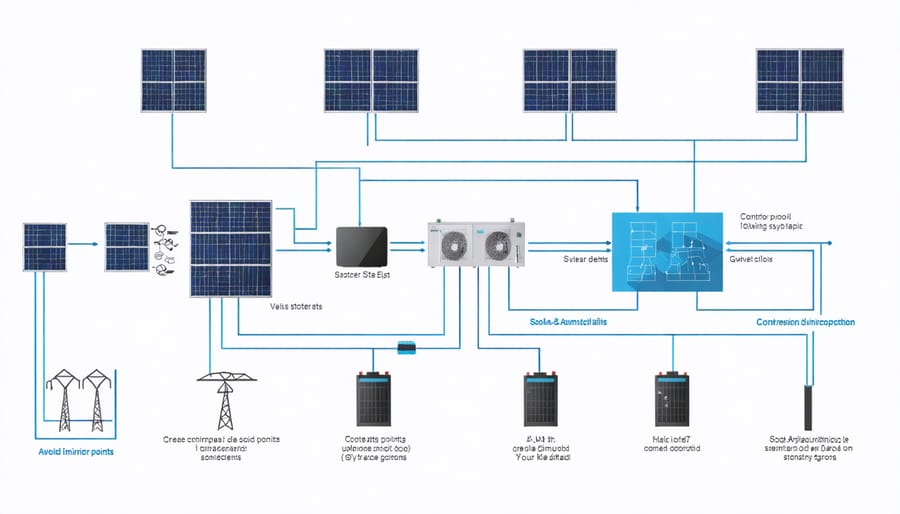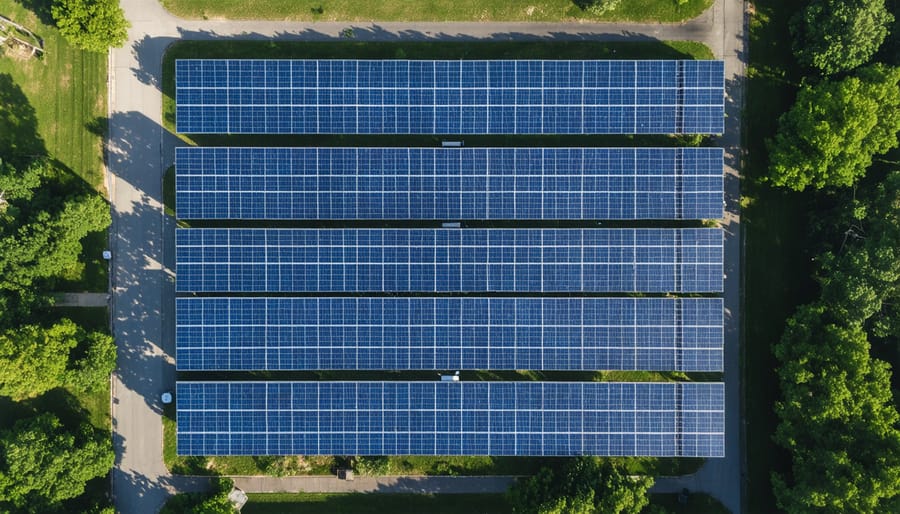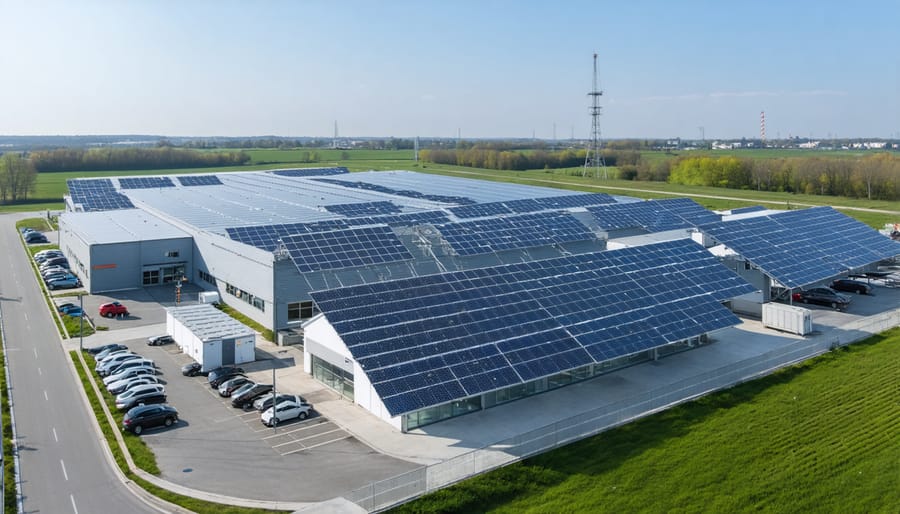Solar Microgrids: The Secret Weapon for Climate-Proof Energy Security

Solar microgrids are revolutionizing Europe’s approach to energy independence and climate resilience. These localized power systems, combining solar panels, energy storage, and smart distribution networks, enable communities to maintain critical operations even when the main grid fails. As extreme weather events become more frequent across Europe, solar microgrids offer a proven solution for energy security while advancing the continent’s ambitious renewable energy targets.
Unlike traditional power infrastructure, solar microgrids create self-sustaining energy ecosystems that can operate independently or in conjunction with the main grid. This dual functionality provides essential backup power during outages while contributing to daily clean energy generation. For European businesses and communities, these systems represent a strategic investment in both operational resilience and sustainability goals.
Recent implementations across Europe demonstrate the transformative impact of solar microgrids. From powering remote Alpine villages to supporting urban industrial complexes, these systems consistently deliver reliable, clean energy while reducing carbon emissions and energy costs. As the European Union accelerates its transition to renewable energy, solar microgrids are emerging as a cornerstone technology for building a more resilient and sustainable energy future.
Understanding Solar Microgrids: Beyond Traditional Power Systems
Core Components of a Solar Microgrid
A solar microgrid consists of three fundamental components that work in harmony to deliver reliable, sustainable power. At its heart are the solar photovoltaic (PV) panels, which convert sunlight into electricity. These panels are strategically positioned to maximise solar exposure and can be installed on rooftops, ground-mounted arrays, or integrated into building materials, depending on the specific smart microgrid design.
The second crucial element is the energy storage system, typically comprising advanced battery technology. Modern lithium-ion batteries or alternative storage solutions enable the microgrid to store excess energy generated during peak sunlight hours for use during nighttime or cloudy conditions. This storage capability ensures continuous power availability and system reliability.
The third component is the intelligent control system, often called the microgrid controller or energy management system (EMS). This sophisticated technology orchestrates the entire operation, managing power flow between generation, storage, and consumption points. It monitors system performance, optimises energy usage, and can seamlessly switch between grid-connected and island modes when necessary.
Supporting these core components are power conversion equipment (inverters and transformers), protection devices, and monitoring systems. Together, these elements create a resilient and efficient power network that can operate independently or in conjunction with the main grid, providing sustainable energy solutions for European communities and businesses.

How Solar Microgrids Operate
Solar microgrids operate through a sophisticated combination of solar panels, energy storage systems, and smart control technologies to provide reliable power distribution. These systems can function in two primary modes: grid-connected and island mode, offering flexibility and enhanced solar energy reliability for European communities.
In grid-connected mode, the microgrid maintains a seamless connection with the main utility grid while generating and distributing solar power locally. This allows for optimal energy management, where excess solar production can be exported to the main grid, and additional power can be drawn when needed. Smart controllers continuously monitor power flow, automatically adjusting to maintain stability and efficiency.
During island mode, the microgrid operates independently from the main grid, typically activated during power outages or planned maintenance. Advanced battery storage systems ensure continuous power supply, while intelligent load management prioritizes essential services. The transition between modes happens automatically through sophisticated switching mechanisms, ensuring uninterrupted power delivery to connected buildings and facilities.
Modern microgrids incorporate real-time monitoring and control systems that optimize performance based on energy demand, weather conditions, and grid status. This intelligence enables predictive maintenance, demand response capabilities, and enhanced energy efficiency, making solar microgrids an increasingly popular choice for sustainable power infrastructure across Europe.
Climate Resilience Benefits
Weather-Independent Power Supply
Solar microgrids excel in providing reliable power supply regardless of weather conditions, making them increasingly vital for energy resilience for businesses and communities across Europe. During extreme weather events, when traditional power grids often fail, these systems maintain continuous operation through sophisticated energy management and storage solutions.
The key to this weather independence lies in the microgrid’s ability to automatically switch between multiple power sources. When solar production is reduced during storms or overcast conditions, the system seamlessly transitions to stored energy from battery banks. Advanced weather monitoring systems integrated into modern microgrids can anticipate weather changes and adjust energy distribution accordingly, ensuring optimal performance even in challenging conditions.
In regions experiencing frequent weather-related disruptions, solar microgrids have demonstrated remarkable resilience. During the severe storms that affected parts of Northern Europe in recent years, communities with microgrid installations maintained power while surrounding areas experienced extended outages. The systems’ robust design includes weather-resistant solar panels, reinforced mounting structures, and protected power electronics that can withstand harsh conditions.
Moreover, solar microgrids incorporate smart load management features that prioritize essential services during extreme weather events. This ensures critical operations continue uninterrupted, while less crucial functions may be temporarily reduced to conserve energy. The combination of intelligent energy management, robust hardware, and advanced storage solutions makes solar microgrids an increasingly popular choice for organizations seeking to maintain operations regardless of weather conditions.

Rapid Recovery and Adaptation
Solar microgrids have repeatedly demonstrated their exceptional resilience during climate-related disruptions across Europe. During the severe storms that hit Northern Germany in 2021, communities equipped with solar microgrids maintained power supply for essential services while surrounding areas experienced extended blackouts. The microgrid systems automatically isolated from the main grid during the disturbance and seamlessly transitioned to island mode operation.
In Southern Spain, during the intense heatwaves of 2022, solar microgrids proved invaluable when traditional grid infrastructure was strained by unprecedented cooling demands. Local businesses and residential complexes with microgrid installations maintained operations while implementing smart load management strategies, effectively reducing strain on the main power grid.
The Netherlands offers another compelling example, where coastal communities facing increasing flood risks have integrated solar microgrids with advanced weather monitoring systems. These installations can preemptively switch to island mode when severe weather threatens grid infrastructure, ensuring continuous power supply for critical flood defence systems and emergency services.
A particularly noteworthy case emerged in Portugal, where a industrial park’s solar microgrid restored power within minutes following a wildfire-related grid failure. The rapid recovery prevented significant production losses and demonstrated how microgrids can safeguard economic activities during climate emergencies.
These examples highlight how solar microgrids not only provide immediate resilience during extreme weather events but also adapt to varying environmental challenges. The systems’ ability to rapidly recover and maintain essential services has made them an increasingly vital component of climate adaptation strategies across Europe.
Implementation in European Communities
Case Studies: From Cities to Industrial Sites
The success of solar microgrids across Europe demonstrates their versatility and effectiveness in various settings. In Barcelona, Spain, the 22@ Innovation District implemented a comprehensive microgrid system in 2019, powering 12 commercial buildings and reducing grid dependency by 40%. The project combines 500kW of rooftop solar panels with smart energy management systems, serving as a blueprint for urban sustainability.
In rural Sweden, the village of Simris achieved energy independence through a community microgrid project. The installation powers 140 households with a combination of 500kW solar array and 440kW wind power, supported by a 800kWh battery storage system. This project demonstrates how remote communities can achieve energy resilience while maintaining grid stability.
Industrial applications show equally impressive results. The Port of Rotterdam’s solar microgrid initiative, launched in 2020, now powers multiple terminal operations and electric vehicle charging stations. The system includes 5MW of solar capacity and 10MWh of battery storage, reducing the port’s carbon emissions by 3,500 tonnes annually.
In Germany, the Audi manufacturing facility in Ingolstadt operates a sophisticated microgrid incorporating 12MW of solar capacity. This installation not only powers critical manufacturing processes but also provides frequency regulation services to the local grid, showcasing how industrial microgrids can serve multiple purposes while enhancing energy security.

Integration Challenges and Solutions
While solar microgrids offer numerous benefits, implementing them successfully requires careful consideration of several key challenges. Grid synchronisation often presents the first hurdle, as integrating renewable energy sources with existing power infrastructure demands precise technical coordination and sophisticated control systems.
Storage system integration poses another significant challenge, particularly in European climates with varying seasonal solar production. Selecting appropriately sized battery systems and ensuring their optimal performance throughout the year requires detailed energy consumption analysis and strategic planning.
Control system complexity can also be daunting, but modern automation solutions have made management more straightforward. Smart monitoring systems help maintain grid stability and optimize energy distribution, while advanced forecasting tools enable better demand-response management.
Regulatory compliance presents varying challenges across different European regions. Working with experienced consultants familiar with local regulations can streamline the approval process and ensure all technical requirements are met.
These challenges can be effectively addressed through:
– Comprehensive site assessment and system design
– Professional installation by certified technicians
– Regular maintenance and monitoring
– Phased implementation approach
– Partnership with experienced system integrators
Most implementation obstacles can be overcome through proper planning and expertise. The key lies in selecting appropriate technology partners and maintaining a systematic approach to project execution, ensuring long-term system reliability and performance.
Future-Proofing Your Energy Infrastructure
When planning for a sustainable energy future, implementing resilient energy systems like solar microgrids requires careful consideration and strategic planning. Begin by conducting a comprehensive site assessment to evaluate your current energy needs, available space for solar installations, and local climate conditions. This baseline analysis will help determine the optimal system size and configuration.
Consider future expansion possibilities when designing your microgrid infrastructure. Installing additional capacity and connection points during initial construction can reduce costs for later upgrades. Smart inverters and advanced energy management systems should be included to ensure compatibility with emerging technologies and evolving grid requirements.
Storage solutions play a crucial role in future-proofing your installation. While current battery technology might meet today’s needs, design your system with the flexibility to incorporate new storage technologies as they become available. Consider a modular approach that allows for easy upgrades and replacements of individual components.
Regulatory compliance is another key consideration. Stay informed about upcoming European energy policies and grid codes to ensure your system remains compliant. Work with experienced providers who understand local regulations and can help navigate future changes in standards and requirements.
Maintenance and monitoring capabilities should be built into your system from the start. Modern microgrids benefit from sophisticated monitoring systems that can predict potential issues before they occur, optimizing performance and extending system life. Regular maintenance schedules and clear operational procedures should be established during the planning phase.
Finally, consider cybersecurity measures in your design. As energy systems become increasingly connected, protecting against digital threats becomes crucial. Implement robust security protocols and ensure your system can receive regular security updates to guard against evolving threats.
Solar microgrids represent a transformative solution for Europe’s energy landscape, offering a perfect blend of sustainability, reliability, and economic efficiency. As we’ve explored throughout this article, these innovative systems provide communities and businesses with unprecedented control over their energy production and consumption while contributing to climate resilience.
The key advantages of solar microgrids – from enhanced energy independence and reduced carbon emissions to improved grid stability and cost savings – make them an invaluable tool in Europe’s transition towards sustainable energy. Their ability to operate both independently and in connection with the main grid provides essential flexibility for future energy challenges.
As climate change continues to impact our energy infrastructure, implementing solar microgrids becomes not just an option but a strategic necessity. For European homeowners, businesses, and communities considering this technology, the time to act is now. Start by assessing your energy needs, consulting with qualified solar specialists, and exploring available incentives in your region.
Remember that successful microgrid implementation requires careful planning, proper system design, and ongoing maintenance. However, the long-term benefits – including reduced energy costs, increased property value, and enhanced energy security – far outweigh the initial investment.
By embracing solar microgrids, we can actively participate in building a more resilient and sustainable energy future for Europe while protecting our communities against climate-related disruptions.
Leave a Reply